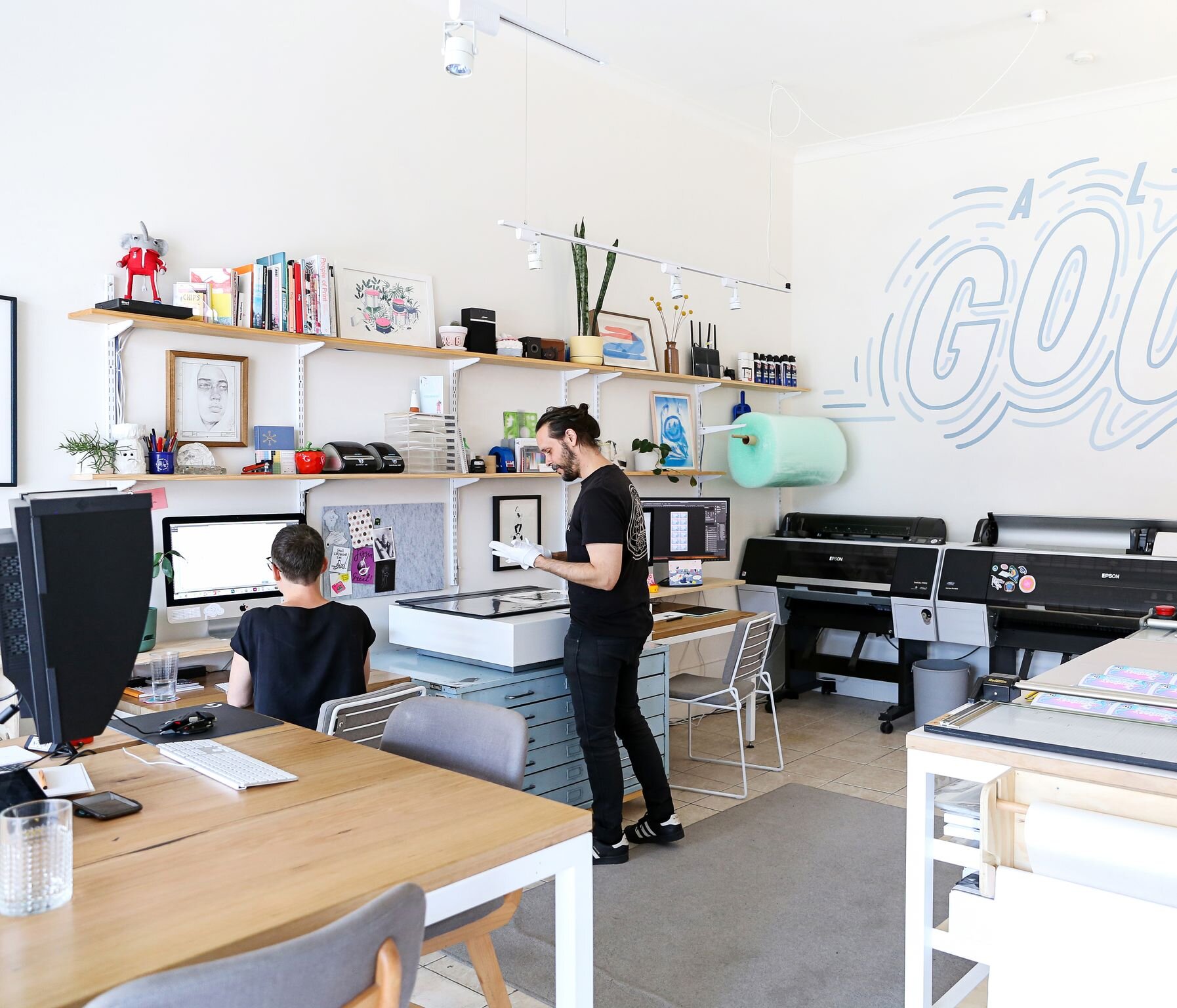ART | Printing your own art with Hound & Bone
The Hound & Bone Studio in Melbourne.
Part of buying art for any budget is getting a little creative with what we are including in our art collections and interior decor. This can be printing your own (or a willing friend’s) photo or commissioning an illustration. While hunting for the perfect printers for my house illustrations I came across Cassie and Pete at Hound & Bone who are a Melbourne based business. Working with Hound and Bone was not only extremely seamless and easy to do but knowing exactly who is behind the small business is important to me. I have always loved hearing how creatives get to where they are so I have found out a little bit more about how Hound and Bone came about.
I see you guys both have creative backgrounds. What led you to set up your printing business Hound and Bone?
Pete already had a number of years experience working in fine art printing. He left the industry to help some friends build their small hospitality business and really missed printing and working with artists. Pete had the printing experience and I had the business skills, so we set about building our own biz!
What is the history behind the name?
My last name is Bone, and Pete had Basset Hounds growing up. The name started off as a bit of a joke that just stuck. We started the business before we had our dog Dash, but she's fit right in ;) .
What’s your favourite thing about running your own business?
The best part is definitely the people we meet through our work. We've met some incredible people who we've become really good friends with, and now hang out with outside of a work context. We also get to meet amazing artists everyday - some of whom are just starting out and already have this immense talent. It's a real privilege.
What is the hardest thing about working with artist reproductions?
Could you clarify this question a bit? Do you mean actually reproducing original artworks into prints (through the digitisation process) or managing people's expectations of the print process?
What sort of art do you like and how has that developed over time?
As evident from the art in the studio, we have a really varied range of tastes! Both of us are really visual people and so generally are drawn to an artwork because of the feeling it evokes rather than it's formal qualities.
How do you go about buying your own art?
Generally we buy art from artists we work with - we're exposed to so many incredible pieces that it's really hard not to buy more! We often go to a lot of exhibitions (pre-COVID of course) and tend to make a purchase at more exhibitions than not. We do end up spending a bit on artwork, but it's such a meaningful investment.
What is the hardest thing about working with artist reproductions/managing people’s expectations of the print process?
It's really important to understand that a print will only ever be as good as the file we're given to work with - having quality source material is absolutely critical to getting an excellent print result. We can make edits/improvements to a file, but if the source material is poor, there's only so much that can be done. It's worth putting in the investment (whether that investment be your time, or a financial investment to pay a professional) to have an excellent file made first, before you do anything else. If you do this right the first time around, you'll never need to do it again for that particular artwork and it will see you end up with consistent, terrific results in print.
What do you wish more people knew about art or the printing process?
1) Your print will only ever be as good as the file we're working from. It's really worth putting in the investment (whether that investment be your time, or a financial investment to pay a professional) to have an excellent file made first, before you do anything else. If you do this right the first time around, you'll never need to do it again for that particular artwork and it will see you end up with consistent, terrific results in print.
2) Even though our process is digital, there's a lot more involved than simply sending your file to our printer. Each file needs to be inspected prior to print, so that we can check for any potential issues with the file that may affect the quality of the final print. We do things the old fashioned way - each file is carefully checked by a human eye rather than an automated software algorithm that are becoming popular. From there, each individual sheet or roll is hand fed into the printer. Unlike large commercial offset presses, we can't print hundreds copies within a small time frame (for example, one A4 print takes about three minutes) so the printing process can take some time depending on the size of your order, or the size of your print. Following printing, we need to inspect the final print (allowing out-gassing time in some cases) for any irregularities - working with natural materials like fine art papers means that there can be undesirable imperfections in the substrate surface or the inkjet coating, and it's our job to detect these. They can sometimes be tiny and easy to miss! From there, the print is hand trimmed to final size and then packaged in archival materials ready for its new home. If you've ever wondered why fine art printers take a little longer than other types of printers, hopefully this explains it!
Keen to know more? Check out my Workshop page to register for the Art for interiors workshop or message me an image of your wall on instagram for some assistance with your art selections.


